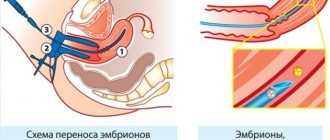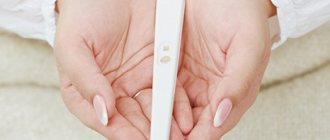Home / Other
Back
Published: 10/19/2020
Reading time: 9 min
0
43
- What is the menstrual cycle
- At what age do girls get their first periods? Is it normal for girls aged 11, 12, 13 to have their first period?
- The easiest way to find out when you will get your period for the first time Test for girls to see when your first period will appear
- What affects the onset of menstruation
- How long does menstruation last?
- At what age do girls start menstruating?
Test for girls when their first period starts
When will I get my first period?
For every girl, the onset of her first menstruation is an important life event, indicating that a new stage of growing up has begun.
And, of course, she is interested in when to expect her period, because everyone starts at different ages. At first glance, it may seem that it is not possible to predict at least the approximate time of the onset of menstruation. But there is such a chance. You just need to take the test for girls “When will your first period start” and answer a few simple questions to get the long-awaited answer. Let's figure out who needs testing. First of all, it is relevant for those who already have assumptions that menstruation will begin soon. Knowing approximately the time of its onset, you will be able to protect yourself by putting a sanitary pad in your backpack just in case. The test will also help satisfy a girl’s usual interest, because it is very difficult not to take any action if you are tormented by some question, especially concerning your own body. And one more situation when it’s worth getting checked - menstruation should have already arrived, but for some reason it hasn’t.
Who should get tested when they get their first period?
The changes in body and mind that occur during hormonal changes are often frightening, and menstruation, if its onset comes as a surprise, can be very frightening.
To prevent this from happening, answer a few simple questions to find out the approximate time of its onset right now. A quick test when you get your first period is also worth taking if:
- there are suspicions that this will happen very soon;
- I want to know in advance so as not to end up in an awkward situation;
- I wonder how long to wait for the transition to the next stage of growing up;
- you think that they should have already begun, but this does not happen.
What is the test for girls “When will the first period begin”
There's nothing wrong with testing. Don't be afraid of tricky questions that can put you in an awkward position. The test for girls “When will the first period begin” is based on the assessment of physical parameters, genetic characteristics and hormonal changes. It was developed by specialists and taking into account large-scale statistics, so its results will be as close as possible to the real state of affairs. You will be able to find out at what time period menstruation should begin, and thoroughly prepare for this significant event, first of all, morally.
There is no need to worry while taking the “When will your first period” test for girls? You know perfectly well the answers to all the questions that are here. The main thing is to answer honestly and as accurately as possible in order to get a reliable result. This testing is one of those cases when, before giving an answer, you need to think carefully in order to choose the truthful option.
Take the test without fear, because you should know as much as possible about your body. By spending about 15 minutes testing, you will be able to get an answer to one of the most important questions that worries girls of your age.
Online test: when will your first period start?
All girls begin their periods at different times. But teenagers and their mothers express a desire to know the exact date. To do this, doctors advise closely monitoring changes in the body. You can compare your observations with information on the Internet and take a test: when will your first period begin.
Despite the existence of a medical norm (11–13 years), it cannot be called a violation if a child first starts menstruating at 10 or after 14 years. Particular attention must be paid to the absence of monthly discharge after the age of fifteen.
Among all the online tests for girls’ first periods, this one allows you to get the most accurate results, although each organism is individual and not all signs appear at the same time.
The easiest way to find out when you're getting your period for the first time
Any young lady is interested in what month a significant event will occur, especially if someone has already started to have periods.
There are different ways to get the information you need, for example, you can go to the doctor with your mother or read articles on the Internet, but it is much easier and more fun to take a virtual check on our website. To complete tasks and find out how soon time “X” will come, you don’t need to register or spend money - our service is absolutely free and available around the clock. Naturally, not a single online test for girls when their first periods begin will give a 100% result and will not say that, say, on such and such a day everything will happen. But even knowing the approximate time will allow you to mentally prepare and stock up on personal hygiene products, just in case. Our testing is compiled by professionals, so it gives the most accurate answer to your question as possible. To find out, just click the “Get Started” button!
Every mother of a young princess is preoccupied with the question of when her daughter will begin. Usually it falls on the mother’s shoulders to tell her daughter about the physiological characteristics of the female sex, as well as explain what menstruation is and how it proceeds.
In this article, we will tell you about when girls' periods most often begin, and by what signs you can suspect their imminent onset.
When should girls get their periods?
Typically, menstruation in teenage girls begins at 12-14 years of age. However, all children have different physiology, and some may start their periods earlier, while others may start later. The normal age range for the onset of the first menstrual flow is considered to be from 10 to 16 years. If your daughter’s period started too early, or at 17-18 years old she still doesn’t have it, this is a reason to visit a gynecologist.
The first menstruation usually lasts about 3-5 days. In some cases, critical days may be slightly delayed, but the discharge should not last more than a week. Most often, the first periods are not heavy, but still give the girl a lot of discomfort.
The next period can begin in 28-30 days. However, in most cases, young girls have irregular periods for a long time, and the interval between spotting can be up to 6 months. Gradually, a girl’s menstrual cycle should shorten, approaching the ideal “lunar” value of 28 days. If, after two years after the start of the first menstruation, the cycle has still not returned to normal, the girl should consult a doctor.
How can you tell when a girl's period starts?
You can determine the time when girls start menstruation by the following signs:
- You will be able to notice the very first signs of your daughter’s puberty several years before the onset of her first period. The girl's figure becomes more feminine and rounded, the sebaceous and sweat glands begin to work in full force. Most teenagers develop acne at this age.
- A few months before the onset of the first menstruation in girls, the nature of vaginal discharge changes. Most often, mothers notice that there is a lot of moisture on their daughter’s panties that does not have any foreign odor. Also, the discharge may be viscous and transparent. If you notice yellowish discharge on your child’s underwear that has an unpleasant odor, this is a reason to consult a doctor. Perhaps they indicate the presence of some infectious disease of the genitourinary system.
- Finally, 1-2 weeks before the approach of menstruation, a girl may experience changes in her condition such as frequent mood swings, discomfort in the lower abdomen, weakness and malaise, headache and dizziness, vomiting and nausea.
Test for girls “When will your first period start?”
Today, on popular Internet sites, as well as in various women's magazines, you can find a test to determine the time when girls start their periods. The result of such tests is most often based on the girl’s answers to questions such as:
- How old are you?
- At what age did your mother start getting her period?
- What is your weight and height?
- How long ago have your breasts started to get bigger?
- Is your pubic hair and armpit hair growing?
- Have you noticed white discharge on your panties?
Such tests can be quite accurate, but do not forget that each person is individual, and the time when a girl begins her first period depends on many factors.
The first period is a long-awaited, but at the same time joyful, exciting, and even frightening event. After all, they will be the signal that yesterday’s girl has turned into a girl, that she has now acquired a completely new status, thanks to which she can perform a real miracle - give a new life.
Teenagers experience the anticipation of menstruation in completely different ways. Some are absolutely calm and don’t even try to understand the essence of the upcoming changes, while others have long since found out the points of interest from their mother or older sister and are fully prepared for growing up. But in the minds of most girls, the stream of questions related to this does not dry out. They scrupulously study various websites, communicate on forums, download special applications to smartphones, etc. And without exception, everyone is trying to find a test that will allow them to accurately determine when their periods will begin and what the first signs of menarche are. Is there a universal way to calculate the arrival of menstruation, how accurate is it, and how can you still understand that the regulations are “on the threshold” - we will find out further.
Express test
Many mothers and their daughters are interested in how to understand from a test that their periods will begin very soon for the first time, and whether this is even possible. There are a number of signs that indicate the imminent approach of menarche:
- sudden change of mood;
- unusual tearfulness;
- discomfort in the lower abdomen;
- general weakness;
- slight malaise;
- dizziness;
- minor headaches;
- nausea;
- vomiting (rare);
- swelling of the mammary glands;
- the appearance of profuse leucorrhoea.
Now mark each of the symptoms that the girl has and evaluate the result by the number of points:
- Less than 3. The sensations are short-term and are not associated with changes in the reproductive system.
- From 3 to 5. Symptoms indicate imminent bleeding if symptoms include breast swelling, mood swings, or pain in the lower abdomen.
- More than 5. The answers indicate that the likelihood of getting your first period is very high. Therefore, you need to talk to the girl, explain the upcoming changes and buy pads.
Carrying out tests on the date of the first menstruation does not give an absolutely accurate result. A teenager's body develops at its own pace. And even if all the signs are present, the menstrual cycle may be delayed due to external factors or individual characteristics.
If the child does not have health problems, then there is no need to worry. And if you suspect delayed or early development, it is better to go to the hospital together and find out what is preventing the onset of menstruation or what triggered premature puberty.
Is your menstrual cycle normal?
According to medical statistics, in Europe, 2 out of 3 women suffer during menstrual periods: nagging pain in the lower abdomen, dizziness, nausea, “jumps” in blood pressure, sudden mood swings, depression, lack of or, conversely, increased appetite, soreness of the mammary glands , insomnia, swelling - all this is not a complete list of our problems. Most women get by with analgesics and patience, but doctors are increasingly calling for more effective solutions. Is your cycle normal? To test this and get advice on overcoming monthly problems, take this test. For each answer A, give yourself 6 points, B - 3 points, C - 0 points.
1. My first period came during the period... A - from 11 to 14 years old B - from 15 to 18 years old C - later (or earlier) and with problems
2. I know about premenstrual syndrome (PMS) that... A - my mood and appetite change B - sometimes I feel nauseous, my breasts hurt and swell C - its manifestations are truly terrible for me!
3. I have pain during menstruation: A - on the first or second day and not very strong B - all days, sometimes I have to take painkillers C - they make me climb up the wall, sometimes I lose consciousness!
4. My cycle is: A - from 26 to 31 days B - from 21 to 25 days C - irregular (or frequent failures) 5. The duration of menstruation ranges from: A - from 3 to 5 days B - from 2 to 4 days B - about week 6. Sex in my life... A - constant with one partner B - constant with several partners C - irregular
7. As a means of protection against unwanted pregnancy, I use: A - the calendar method, interrupted sexual intercourse (or I do not protect myself at all) B - hormonal contraception C - condoms 8. Intimate life for me: A - one of the highest pleasures B - something what you can’t deny yourself B - something that, unfortunately, you can’t always deny a man
9. After pregnancy, my periods... A - are easier and shorter B - at the same level (or I simply haven’t been pregnant yet) C - have become much heavier and more painful 10. During my periods I... A - I hardly change the usual rhythm of life B - especially attentive to yourself B - I lie flat and cry
If you scored from 60 to 40 points , most likely there is no need to sound the alarm! Even if there are certain problems, in general your cycle is normal. Do not forget to visit your gynecologist 2 times a year and select hormonal contraceptives only on the advice of a doctor.
Painful sensations during critical days can be endured - lie down without taking painkillers (why put extra stress on the liver?), or you can relieve pain and relieve spasms using heat. FRAUPLAST thermal plaster can help you with this . It contains only natural ingredients, it has no side effects, is absolutely safe, completely invisible under clothing and easy to use. Under no circumstances should you engage in intense or prolonged physical activity during these days, even if you feel great. Avoid prolonged water procedures, despite modern high-quality means of protection. Drink more fortified drinks. You can add rosehip and hawthorn syrup to tea.
From 39 to 19 points - you should tell your gynecologist about your problems during your menstrual period and undergo an examination. Avoid hypothermia and overheating of the body. Avoid sudden changes in temperature - saunas and steam baths are not recommended for you even outside of critical days! However, lying flat and complaining about life is also not worth it. Take a walk outside. Stick a thermal plaster on your underwear before leaving the house, and for the next six hours you will feel a pleasant warmth, which in 15–20 minutes will carefully and gently relieve all unpleasant pain. Treat yourself to your favorite treat. Drink pomegranate and blackcurrant juices. And, having received the recommendations of your doctor, follow them carefully. It is likely that you will have to change something in your usual lifestyle in order to establish a normal and pain-free cycle. Less than 18 points - you should be wary and run to the doctor! Analyze your lifestyle yourself! Maybe you are chronically sleep-deprived? Do you live in a constant state of stress? Do you suffer from migraines? Do you lead a sedentary lifestyle or, on the contrary, exhaust yourself with physical activity and diets? Your attending physician should certainly find out all these factors during the examination. Most likely, in addition to the course of therapy, you will be recommended a radical revision of your lifestyle, including your relationship with the intimate sphere.
When will the first period start test for girls
There comes a time in every girl's life when her body changes. The figure becomes more feminine, breasts begin to form, and with it the menstrual cycle, the first periods appear. All these processes are interconnected, so it is very important to explain and prepare the girl for these important metamorphoses. As a rule, the onset of puberty occurs at 11–14 years of age, but each organism is individual, so critical days can go either later or earlier. In any case, many girls are very worried about the wait. The body often sends clues that will help you predict when your first period will begin. To be prepared for this moment, you can take a simple test to determine the onset of menstruation.
Test for girls for the appearance of their first menstruation
Experts have developed simple tests for girls that help determine when their first period will begin. If a girl is wondering when should I get my first period, she should first answer the following:
- How old are you?
- Are your breasts growing?
- Do you have hair in your armpits and pubic area?
- Have you noticed clear or whitish vaginal discharge?
- Do you experience frequent mood swings?
If the test is passed by a girl of approximately 12 years of age, and all questions are answered positively, then, most likely, the first menstruation will not take long. You need to prepare for this event, carry a sanitary pad with you so as not to get confused at the crucial moment.
Usually a couple of years before the onset of menstruation, the hormone estrogen begins to activate. Under its influence, the uterus and mammary glands grow, the pelvis expands, and a waist appears. The girl's figure begins to take on feminine shape. From now on, you should prepare for the onset of menstruation.
What are the main signs of the imminent onset of menstruation?
Symptoms of approaching menstruation in girls are noticeable even a year before the onset of bleeding. Signs of approaching menstruation in girls are listed in the table below.
| Approximately several years before the onset of menstruation. | In a few months. | Signs that appear a week or several days before the event. |
| Enlargement (swelling) of the breast. | Transparent, white or yellowish discharge on panties that has no odor. If the discharge that appears is of a different color or has an unpleasant odor, you should consult a gynecologist. | Tearfulness. |
| The appearance of hair in intimate places. | Apathy. | |
| Expansion of the hips. | Mood changes. | |
| Some girls experience acne on the skin of their face. | Headache. | |
| Aggression. | ||
| Pain in the lower abdomen. |
The symptoms of PMS in teenagers are the same as in an adult woman. However, girls perceive these signs brighter and more emotionally.
Signs of the appearance of the first menstruation
As a rule, menstruation is accompanied by certain unpleasant sensations. Girls' first periods are no exception, so it is very important to warn about possible symptoms:
- There is nagging pain and a feeling of fullness in the lower abdomen.
- Frequent mood changes are a harbinger of the first menstruation.
- The abdomen may swell.
- Increased sensitivity of swollen mammary glands.
- Signs that your period is approaching may include headache and weakness.
- Bloody vaginal discharge.
What should your first period look like?
Menstruation is manifested by bloody vaginal discharge, which should be dark red or brown in color. The first menstruation is not characterized by increased intensity, but there are exceptions. Girls who encounter this phenomenon for the first time may be scared, but this is a normal manifestation of the first menstruation. The volume of discharge sometimes reaches 150 ml, which does not pose a danger if the girl’s well-being remains within normal limits. But if, with heavy bleeding, you feel dizzy, your face turns pale, or you faint, you should immediately consult a doctor.
What should the first menstrual flow look like?
Many girls, when faced with menstruation for the first time, are very frightened, because previously blood for them was exclusively a sign of injury. Therefore, it is very important to explain to the teenager that in this case the mechanism for the appearance of bloody secretion is completely different, completely understandable and absolutely normal. There is no single standard for what discharge should be like at menarche. Their color may vary, most often the secret is:
- bright red;
- brown;
- burgundy;
- dark brown, etc.
The same applies to the intensity of menstruation - neither scanty nor abundant periods should frighten a teenager, so it is very important to explain all the nuances to the girl in a timely manner.
See also: Is it possible to throw tampons down the toilet?
What to do if your first period starts
If a girl already knows that significant changes in her life and some associated inconveniences await her soon, she should monitor her well-being. Before the onset of the first menstruation, there is a nagging pain in the lower abdomen, mood swings, breast swelling, and the appearance of leucorrhoea in the underwear.
All these signs indicate that you need to be prepared for menstruation at any time, carry a pad and a change of underwear with you. What to do if you get your period for the first time?
- There is no need to panic, this is completely normal.
- First of all, you need to go to the toilet, change your underwear and attach a pad to clean panties.
- If you suddenly don’t have a pad on hand, you can put toilet paper folded several times in your panties. At school, there will probably be hygiene products in the nurse's office, so it's worth asking her for help.
- During your first period, you may experience discomfort in the lower abdomen that is difficult to tolerate. In this case, you should always have means to eliminate pain symptoms with you.
- You can apply a heating pad with cold water to your stomach. This will soothe the pain and reduce the intensity of menstruation. You need to be very careful not to overcool the internal organs.
- If critical days suddenly overtake you and a brown stain appears on your clothes, you can tie a sweater around your waist to hide the trouble, and remove traces of blood with cold water at home.
What happens to the ovaries before menstruation
Puberty occurs after luteinizing and follicle-stimulating hormones begin to be produced in the hypothalamus and pituitary gland. Thanks to them, the formation of estrogen begins in the ovaries. At the same time, significant changes occur in the reproductive system. Oocytes mature and ovulate, and the endometrium develops. This leads to the possibility of conception. The quantitative content of hormones, which is inherent in the menstrual cycles, begins to change.
For the first time there may be pain in the ovaries
At the same time, both during and during menstruation, the ovaries are able to remind themselves with unusual sensations. During these periods of time, nagging pain may appear. However, they should not be very pronounced and long-lasting. Otherwise, when the pain is quite severe, it is necessary to contact a gynecologist, as they may indicate pathology.
If conception does not occur, then menstruation occurs. The egg cell degrades and disintegrates. One of its parts is called the corpus luteum, which produces progesterone. This substance is necessary for the future cycle. When this hormone is not produced enough, partial separation of the endometrium occurs. This leads to unpleasant sensations in the lower abdomen a week before the expected event. This circumstance helps to find out when a girl will start her period. In addition, you need to learn to “hear” your body.
How long does menstruation last?
As a rule, the first period lasts from 3 to 5 days. But due to the unstable initial cycle, this period may vary. However, exceeding a week period may indicate pathology or hormonal imbalances, so you should consult a doctor. The next menstruation should ideally begin in 28–30 days, but in the first stages of the formation of the cycle, such accuracy rarely happens.
Regardless of the age at which the first menstruation began, the cycle may be unstable throughout the year: menstruation is either delayed or comes earlier than expected. This hormonal behavior is considered normal at first, as the normal cycle is being set up. But if after 2 years the menstrual cycle has not stabilized, you should consult a doctor and get tested for sex hormones.
What is the menstrual cycle
The menstrual cycle is periodic hormonal changes associated with the characteristics of the female body. Thanks to it, the body prepares for fertilization. The duration of this period is different for everyone.
The ideal cycle is 28 days (counted from the first day of one menstruation to the beginning of the next). However, normally it can be from 21 to 35 days.
Every woman’s cycle should be regular; deviations of only three days are allowed. Therefore, doctors recommend that women mark the first day of menstruation on the calendar. You should know that during the first year the menstrual cycle may not be constant. The intervals between bleeding can be up to two or even more months.
The normal duration of monthly bleeding is from two to seven days. During one menstruation, a woman loses on average about 40 ml of blood, some up to 80 ml. The menstrual cycle begins during adolescence and continues until a woman reaches menopause.
During your first period, bleeding is usually not very intense.
Hygiene products for girls during menstruation
There are different hygiene products that women use during their periods. But not all of them are suitable for girls during their first critical days.
For girls, sanitary pads are best. They have a special adhesive surface that should be glued to your underwear. The soft, smooth surface comes into contact with the body and absorbs all secretions. Pads come in different sizes, depending on how much liquid they can absorb. Typically, the number of droplets shown on the packaging indicates how much secretion they can absorb.
Opinion of gynecologists
Doctors say that tests that determine the onset of the first menstruation are arbitrary. It all depends on individual characteristics. Hereditary factors, nutrition, lifestyle, previous gynecological diseases - all this can significantly affect the formation of a girl’s cycle. Often, the first critical days come earlier for those who play sports or are overweight, while girls with asthenic physique wait longer for their periods.
The cause of premature menstruation, when it occurs at the age of 8, may be hormonal imbalance, diseases of the thyroid gland, disruption of the ovaries, adrenal glands, and pituitary gland. At the same time, if by the age of 15 a girl has not yet had “those days,” this is a reason for concern, since such a phenomenon may indicate pathologies and delayed sexual development. In both cases, genetic predisposition may be the dominant factor, therefore, to know for sure, you should consult a gynecologist who will help identify the problem and suggest ways to solve it.
It is very important to have support during this period. The mother must warn her growing daughter about what is about to happen to her and what needs to be done. You should also teach the girl to take care of hygiene and monitor her well-being. As for special hygiene products, doctors recommend using pads first. Although many experts do not see any obstacles to using tampons at such a young age, pads will still be more reliable. To be sure, you can use pads with greater absorbency, while tampons should be the smallest.
Signs of the first critical days
If you turn to statistics to find out when girls' first periods begin, you can become even more confused.
According to various opinion polls and studies, menarche can appear at 8–9 years of age, or it can be forced to wait until 15–16 years of age.
In fact, by carefully observing the behavior of your body, you can completely do without various tests and statistical information in order to determine the arrival of menstruation with almost one hundred percent accuracy.
So, let's talk in more detail about the signs that your period is approaching. One of the earliest signals indicating puberty is the appearance of white vaginal discharge. Approximately 8–15 months after this, you can expect the onset of menarche.
During this period, the girl’s figure changes noticeably - a waist appears, breasts and hips increase. In addition, hair begins to grow on the legs, pubic area, and armpits; acne and pimples may appear on the face and back.
All these phenomena are associated with increased hormone production as a result of growing older.
The following symptoms indicate the imminent approach of critical days:
- Pulling and aching pain in the lower back and abdomen.
- Increased sensitivity and even soreness of the breast.
- Frequent mood swings (out of nowhere irritability, aggressiveness, tearfulness).
- Nausea, changes in taste preferences in food, loss or, conversely, increase in appetite.
- Drowsiness or insomnia (sleep disorder).
All of the listed signs are nothing more than PMS (premenstrual syndrome), which is an absolute variation of the norm and should not cause concern if it is not accompanied by other symptoms, for example, fever, discomfort, itching in the genital tract. Such symptoms may indicate an infection in the body and require urgent intervention from a specialist.
What affects the onset of menstruation
As already noted, menstruation in girls occurs between the ages of 10 and 16 years. Its appearance is influenced by many factors. In case of an incorrect lifestyle, menstruation may begin either earlier or much later than expected.
If there are hormonal imbalances, poor nutrition, excess weight or constant fluctuations (obesity, then sudden weight loss), a girl may experience early menstruation. Vitamin D is of great importance for a teenager's body. With its deficiency, girls often experience the onset of menstruation before the age of 9 years.
Teenagers who have suffered from infectious diseases often experience problems with the functioning of the ovaries and the endometrium. In this case, menstruation may begin later than expected. Other factors may also contribute to this problem, for example:
- exhausting diets (fasting);
- constant stress;
- hard, exhausting workouts;
- overweight or underweight;
- unfavorable environment.
Bleeding often occurs later in short and excessively thin girls. With low weight, the girl’s body does not have enough adipose tissue, and estrogen (sex hormone) ceases to be produced in sufficient quantities.
How does the first menstruation go?
The first bleeding for a girl is a very difficult situation. Unpleasant, unusual sensations and the need to change the pad several times a day torment the teenager. During the period from the first to the third day, the heaviest bleeding occurs, which has a specific smell. During this period, we must not forget about personal hygiene, not only because of the “aroma,” but also because this can lead to inflammation of the genitourinary system.
From the third to fourth day, the amount of blood released decreases, the pain goes away, and the girl begins to feel much better. In this regard, you need to learn to determine when the first day of your period will arrive.
What should the first menstrual flow look like?
Many girls, when faced with menstruation for the first time, are very frightened, because previously blood for them was exclusively a sign of injury. Therefore, it is very important to explain to the teenager that in this case the mechanism for the appearance of bloody secretion is completely different, completely understandable and absolutely normal. There is no single standard for what discharge should be like at menarche. Their color may vary, most often the secret is:
- bright red;
- brown;
- burgundy;
- dark brown, etc.
Color
Most often, the color of menstrual blood has a wide palette of red and brown shades, which is determined by the presence of the inner mucous layer of the uterus and vaginal discharge. For this reason, menstruation of light brown, scarlet, dark brown colors is considered physiological.
Duration
It is believed that menstruation is normal, which can last from 3 to 10 days, which also depends on the characteristics of the girl’s body. For the first time, the discharge may be scanty and last only 1-2 days. Do not be upset, because in the next cycle the menstrual bleeding will be full.
Delay
Very often, the first months of the menstrual cycle are quite unstable and it can take a whole year to form, while the interval between bleeding can range from 21 days to 12 weeks. It is generally accepted that this is the norm at the beginning of stabilization.
Cycle
In the first few months, it is very difficult to determine the duration of a girl’s menstrual cycle. Its formation takes place over 24 months. Also, the duration of bleeding and the break between them can be different.
To more accurately record your cycle, you need to keep a calendar and mark the beginning and end of menstruation in it.
This will help the doctor, if necessary, adjust the patient’s hormonal state and determine whether any medications need to be used.
Also, the calendar will help an inexperienced young lady stock up on all the necessary hygiene products on time, which will protect her from unforeseen situations.
Heavy first periods in girls
Heavy discharge during the first menstruation is also an indicator of the norm and directly depends on heredity and the characteristics of the girl’s body.
Results
Growing up as a girl is a responsible process. It is important to properly prepare her for this event, because when faced with menstruation for the first time, a girl may be afraid of bleeding. It is necessary to explain to her that this process is associated with the main female ability - to bear and give birth to a child. There is no need to be embarrassed to ask your mother or older girlfriends for advice, because menstruation is a natural process and every woman experiences it. First period tests can give an approximate start, but much depends on individual factors. You should learn to listen to your body, which gives clear clues, and in case of any deviations, immediately consult a doctor.
Sources:
https://mamochka-club.com/psihologicheskie-testy/testy-dlya-devochek/test-kogda-u-menya-poydut-pervye-mesyachnye.html https://mesyachnyedni.ru/obschie/test-na-pervye -mesyachnye.html https://overtune.ru/podrostki/test-kogda-nachnutsya-pervye









